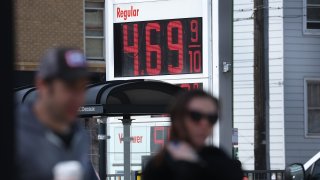
Rising prices have been a concern for many Americans, and a recently released report sheds light on the cities in the United States that are struggling the most with inflation in 2024.
Analysts at WalletHub said the COVID-19 pandemic caused a 40-year high in the U.S. inflation rate but has since cooled down.
As of February 2024, the year-over-year inflation rate sits at 3.2%, which is still above the target rate of 2%. The Federal Reserve may cut interest rates this year rather than increase them further.
To help people understand how inflation affects their local economy, the personal finance company compared 23 major Metropolitan Statistical Areas (MSAs) using the Consumer Price Index.
Get DFW local news, weather forecasts and entertainment stories to your inbox. Sign up for NBC DFW newsletters.
This measures inflation by comparing the CPI for the latest month for which BLS data is available two months prior and one year prior.
Unfortunately, Dallas has reached the top five on the list, posing significant concerns for its residents.
According to the report, Dallas has emerged as the second-highest city in terms of inflation rate.
The overall score for Dallas-Fort Worth-Arlington is 77.78. The Consumer Price Index (CPI) changed by 0.90% in the latest month compared to the previous two months.
Moreover, the CPI increased by 5.30% in the latest month compared to the same period in 2023.
The Houston-Woodlands-Sugar Land area netted the 10th city with the highest inflation rate nationwide, with an overall score of 55.56. The study found that in the last month, the CPI has changed by 1.00% compared to two months before, and there has been a 3.50% jump in the CPI when compared to Feb. 2023.
Miami has the highest inflation rate in the country, with a score of 86.11 in the Miami-Fort Lauderdale-West Palm Beach area.
The CPI has changed by 1.40% in the past month compared to two months prior. Furthermore, it has increased by 4.90% compared to the same month last year.
What are the main factors currently driving inflation?
According to Wenyi Shen, an Associate Professor at Oklahoma State University, the unprecedented expansionary monetary easing and fiscal measures deployed during the pandemic, along with supply-side shocks such as global supply bottlenecks and the Russian-Ukraine war during and after the pandemic, are considered crucial factors driving inflation.
Professor Zdravka Todorova at Wright State University said while the inflation rate has declined, some of its drivers have become structural to the economy. Business practices, utilization of high-tech inputs, concentration, pandemic effects on pricing, environmental and institutional factors, and wars are essential factors that lead to inflationary pressure.
Todorova also stated that environmental factors are drivers of inflation and have become structural. Increased heatwaves, droughts, floods, soil erosion, water shortages, and pollution are not occasional disaster events. They contribute to shortages, uncertainty, and higher costs, as evidenced in multiple vital sectors - food, energy, and automobiles.
The full report, methodology, and additional expert comments can be read on WalletHub's site.



